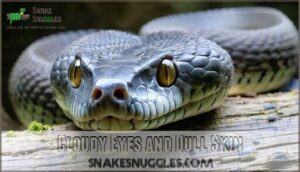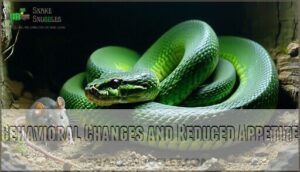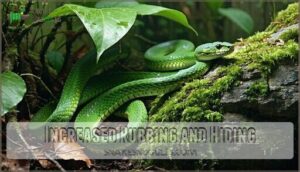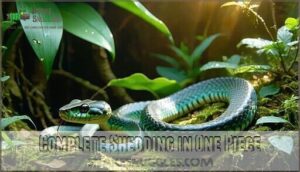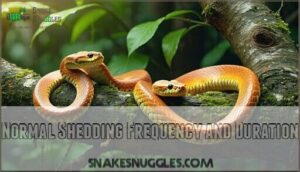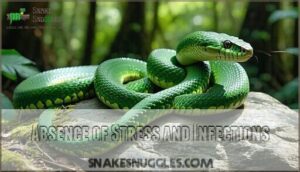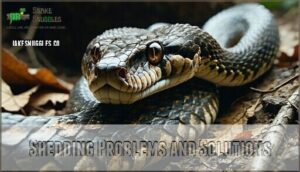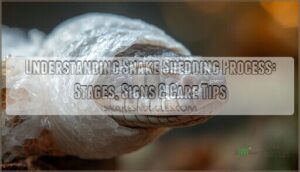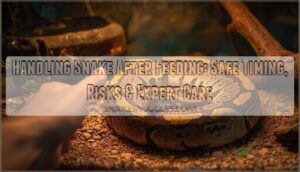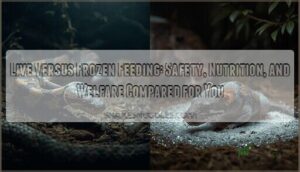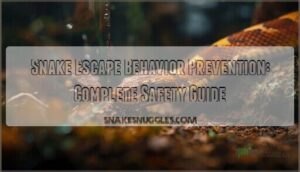This site is supported by our readers. We may earn a commission, at no cost to you, if you purchase through links.
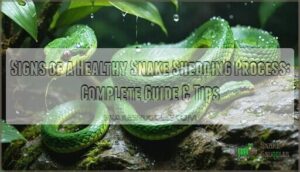 You’ll know your snake’s shedding process is healthy when you spot these telltale signs.
You’ll know your snake’s shedding process is healthy when you spot these telltale signs.
First, their eyes turn milky blue and their skin becomes dull and grayish – think of it as nature’s "under construction" sign.
Your snake might become a bit of a hermit, hiding more and eating less during this time.
The real victory comes when they shed their entire skin in one complete piece, like peeling off a sock, which usually happens every 4-8 weeks for young snakes and less frequently for adults.
A healthy shed means no leftover bits clinging to their body and your snake returns to normal behavior quickly, indicating they are adapting well to their environment, and Understanding these patterns reveals whether your scaly friend needs extra humidity or environmental tweaks.
Table Of Contents
- Key Takeaways
- Snake Shedding Process
- Signs of Impending Shed
- Healthy Shedding Indicators
- Post-Shedding Care
- Shedding Problems and Solutions
- Frequently Asked Questions (FAQs)
- How do I tell if my snake is healthy?
- How often does a healthy snake shed?
- How to know when a snake is done shedding?
- What does a snake look like after shedding?
- How often should a healthy snake shed?
- What are the signs of a reptile going through a shed cycle?
- How do snakes behave immediately after shedding?
- What materials help snakes shed more easily?
- Can improper diets affect snake shedding cycles?
- Do male and female snakes shed differently?
- Conclusion
Key Takeaways
- Watch for complete single-piece sheds – You’ll know it’s healthy when your snake sheds its entire skin in one piece, like peeling off a sock, with no leftover bits clinging to its body.
- Monitor the pre-shed signs – You’ll see cloudy blue eyes and dull, grayish skin about 7-14 days before shedding, plus your snake will hide more and eat less during this time.
- Check shedding frequency to match your snake’s age – Young snakes should shed every 4-6 weeks, while adults shed 2-4 times yearly, and consistent timing indicates good health.
- Maintain proper humidity levels – You’ll prevent stuck shed problems by keeping humidity at 50-60% normally and boosting it to 70-80% during pre-shed phases, plus provide rough surfaces for natural rubbing.
Snake Shedding Process
Understanding your snake’s shedding process helps you recognize when everything’s going smoothly versus when problems might arise.
You’ll notice specific patterns in frequency, timing, and physical changes that indicate healthy skin renewal happening naturally, which can be crucial for identifying potential issues early on, and thus, recognize when to intervene.
Watch for cloudy eyes and dull skin – these telltale signs mean your snake’s preparing for a healthy transformation ahead.
Factors Influencing Shedding Frequency
Several key factors determine how often your snake sheds its skin. Growth rate plays the biggest role – young snakes shed every few weeks during rapid development, while adults slow to just 2-4 times yearly.
Nutritional intake and hydration levels directly impact shedding frequency, as well-fed snakes with proper water access maintain regular cycles.
Environmental factors like temperature and humidity heavily influence the process – ideal conditions support healthy shedding patterns.
Health status matters too, since illness or stress disrupts normal schedules.
Genetic factors create species-specific differences, with some breeds naturally shedding more frequently than others.
Snakes shed to remove dead skin and allow for continued skin growth.
Age and Species-Dependent Shedding
Throughout your snake’s life, juvenile shedding occurs every 2-4 weeks due to rapid growth rate changes, while adult frequency drops to 2-4 times yearly.
This dramatic shift reflects how growth patterns directly influence shedding frequency across different life stages.
Snakes typically shed skin two to four times annually on average.
Species variation plays a huge role too.
Corn snakes shed every 4-6 weeks as youngsters but stretch to 2-3 months as adults.
Ball pythons follow similar patterns, while large constrictors like boas might only shed 2-3 times annually when mature.
Some rattlesnakes barely shed once yearly in old age.
This age and species-dependent shedding creates unique rhythms for each snake.
The lifespan impact means you’ll notice fewer sheds as your pet ages, much like how kids outgrow clothes faster than adults need new wardrobes.
Environmental Factors Affecting Shedding
Three key environmental factors can make or break your snake’s shedding success. Getting these right means the difference between smooth, complete sheds and frustrating stuck skin that requires intervention.
Temperature control creates the foundation for healthy shedding. Your snake needs consistent temperature gradients – typically 88-92°F for basking spots and 75-80°F for cooler areas. These gradients help your snake regulate its body temperature throughout the shedding cycle.
Proper humidity ranks as the most critical factor. Most species need 50-60% humidity during normal times, increasing to 70-80% during pre-shed phases. Low humidity causes stuck sheds, while excessive moisture invites bacterial problems. For specialized tools, consider snake enclosure products.
Enclosure design supports the entire process through:
- Water availability – Fresh water bowls for drinking and soaking
- Humidity levels maintained through proper ventilation and substrate choices
- Seasonal changes accommodated by adjusting environmental factors accordingly
Smart environmental factors management prevents most shedding problems before they start.
Signs of Impending Shed
You’ll notice several clear warning signs that your snake is preparing to shed its skin. These physical and behavioral changes typically appear 7-14 days before the actual shedding process begins.
Cloudy Eyes and Dull Skin
When your snake’s eyes turn that telltale cloudy blue and its skin loses its natural shine, you’re witnessing classic pre-shed signs. This eye opacity and skin discoloration typically appear 7-14 days before the actual snake shedding begins.
Those cloudy blue eyes mean your snake’s about to trade its old skin for a brand new outfit.
The milky appearance results from fluid building between old and new skin layers, causing temporary vision impairment. Don’t worry—this shedding timeline is perfectly normal!
Your snake’s dull skin will soon give way to a brilliant new coat. These reliable snake shedding signs mean a healthy shed is right around the corner.
Maintaining proper humidity helps to avoid retained spectacles issues.
Behavioral Changes and Reduced Appetite
Beyond the cloudy eyes, your snake’s personality takes a noticeable turn during pre-shed hiding periods.
Don’t worry when your pet becomes a recluse – this defensive behavior signals healthy shedding signs ahead.
Here’s what to expect during preshedding signs:
- Appetite decline – Your snake may refuse meals completely
- Increased irritability – Handling attempts trigger defensive responses
- Activity changes – Normal routines shift toward seeking dark spaces
Reduced appetite during snake shedding is perfectly normal.
Think of it like losing your appetite when you’re not feeling well – your snake’s just focused on the big transformation coming up.
Increased Rubbing and Hiding
Recognizing when your snake begins its shedding signs becomes easier once you understand their natural behaviors. Your pet will start rubbing against objects more frequently as old skin loosens. This increased activity helps create the initial opening needed for a complete shed.
You’ll also notice changes in their hiding patterns as they seek secure spots during this vulnerable time.
Watch for these telltale shedding signs that signal the process has begun:
- Rubbing against objects becomes more intense as they work to loosen stubborn skin patches
- Increased activity around their hiding places shows they’re preparing for the big event
- Nose-first rubbing against rough surfaces demonstrates their natural Behavioral Analysis instincts
- Extended time in Enclosure Enrichment items like logs or rocks aids their shedding process
These behaviors are completely normal. Your Observation Techniques should focus on Reducing Stress by maintaining proper humidity and avoiding unnecessary handling. Injury Prevention means ensuring all surfaces are appropriately textured—rough enough to help but not sharp enough to damage delicate new skin underneath.
Healthy Shedding Indicators
Recognizing healthy shedding helps you know when your snake’s natural process is working perfectly. You’ll see clear signs that indicate everything’s going smoothly and your pet is thriving.
Complete Shedding in One Piece
When you find your snake’s shed skin in one glorious piece, you’re witnessing shedding integrity at its finest.
This complete shed indicates superior health and proper husbandry.
The single-piece benefits include fewer complications and smoother phases.
Look for complete shedding signs like intact eye caps and tail tips.
During your post-shed inspection, you’ll notice the old skin resembles a perfect inside-out sock.
This healthy skin renewal process creates vibrant, elastic new scales.
The one piece shed demonstrates your pet’s environment supports natural molting cycles perfectly.
Normal Shedding Frequency and Duration
Understanding your snake’s normal shedding frequency helps you track their health like a growth chart.
Most snakes follow predictable shedding intervals based on age correlation and species differences.
Here’s what to expect for regular shedding:
- Juveniles: Shed every 4-6 weeks due to rapid growth rate
- Adults: Shed 2-4 times yearly with slower growth patterns
- Species differences: Ball pythons shed more frequently than boas
- Seasonal variation: Some species shed more during warmer months
Consistent shedding that matches your snake’s age and species-dependent shedding timeline indicates proper husbandry and good health.
Absence of Stress and Infections
After your snake completes its stressfree shed, you’ll notice several key indicators of post-shed health.
A healthy environment guarantees no skin fragments remain stuck on the body or tail. Clear eye caps indicate successful shedding without complications.
Your snake should display bright coloration and normal appetite within days.
Handling impact during shedding can cause stress, so wait until the process completes naturally.
Watch for infection prevention signs like smooth new skin without wounds or retained patches that could harbor bacteria.
Post-Shedding Care
Once your snake completes its shed, you’ll want to check that everything went smoothly.
This is a crucial step to ensure your snake’s health and well-being, and it can be thought of as helping a friend after they’ve just gotten out of a really tight wetsuit.
They need the right environment to feel comfortable again, which includes setting up conditions for recovery.
Providing Optimal Humidity and Temperature
After your snake completes shedding, humidity control becomes your priority partner in recovery.
Maintain 50-60% humidity levels with proper humidity through strategic water bowl placement and substrate dampening.
Create temperature gradients with basking zones at 88-92°F and cool areas at 75-80°F.
Species needs vary, so research your snake’s specific requirements.
Use digital monitoring tools like hygrometers for accurate readings.
Smart enclosure design with humid hides provides adequate hydration options.
Digital hygrometers are essential for accurate humidity monitoring.
Think of it as creating a snake spa – temperature and humidity work together for ideal healing.
Monitoring for Retained Eye Caps
After confirming proper humidity and temperature, Post-Shed Inspection becomes your next priority. Think of Eye Cap Identification like checking for leftover tape after unwrapping a present – those stubborn retained eye caps can stick around and cause trouble.
Preventing Eye Caps starts with careful examination after each shedding process. Look for these postshedding signs:
A good resource for snake eye cap products can help with addressing this issue.
- Crystal-clear eyes – healthy eyes should look bright and transparent, not cloudy or milky
- Normal blinking patterns – your snake should blink naturally without any hesitation or difficulty
- No opaque patches – any foggy areas indicate incomplete snake shedding requiring attention
Safe Removal Methods exist, but Veterinary Assistance guarantees proper snake health when problems arise.
Offering Rough Surfaces for Rubbing
Strategic placement of abrasive materials transforms your enclosure into a natural shedding sanctuary.
Position rough-textured branches, cork bark, or specialized substrates where your snake travels most.
These surfaces become essential tools during the shedding process, allowing natural rubbing against objects that loosens stubborn skin patches.
| Surface Type | Benefits |
|---|---|
| Cork bark | Natural texture prevents injury while promoting healthy shed |
| River rocks | Smooth yet abrasive – perfect for gentle skin removal |
| Textured branches | Multiple angles for complete body coverage during smooth shedding |
Many keepers source reptile enclosure cork for this purpose.
Proper enclosure enrichment with varied textures prevents stuck shed complications while supporting your snake’s instinctive behaviors, which is crucial for a healthy shed and overall well-being.
Shedding Problems and Solutions
While most snakes shed naturally without issues, problems can arise when conditions aren’t right.
You’ll need to recognize warning signs early and know how to help your snake through difficult sheds safely.
Incomplete Shedding and Stuck Shed
While proper post-shedding care helps most snakes, some still face shedding complications. Dysecdysis causes include low humidity, dehydration, and poor nutrition.
When stuck shed occurs, don’t panic – you’ve got options.
Common shedding problems include:
- Eye cap retention: Use damp cotton swabs for gentle removal of stubborn eye caps
- Partial skin patches: Increase humidity to 60-70% and offer soaking solutions in lukewarm water
- Tail tip issues: These spots often need extra attention during humidity control efforts
Preventative measures work better than fixes. If retained shed persists after soaking attempts, veterinary intervention becomes necessary. Your vet can safely remove problem areas without causing injury.
Parasites and Infections During Shedding
Beyond stuck shed issues, you face another threat: uninvited microscopic guests that can wreck your snake’s health during vulnerable shedding periods.
Mite Infestations appear as tiny black or red specks around your snake’s eyes and mouth. Bacterial Infections and Fungal Diseases love compromised skin barriers during sheds, causing nasty lesions and scale rot. Boa constrictors can experience dysecdysis abnormalities, which can further complicate shedding.
| Parasite/Infection Type | Key Symptoms |
|---|---|
| Snake Mites | Black specks, excessive rubbing |
| Scale Rot | Blistered, foul-smelling scales |
| Fungal Disease | Thickened, crusty skin patches |
| Internal Parasites | Weight loss, poor appetite |
| Secondary Infections | Ulcerated areas, lethargy |
Preventative Measures include proper quarantine and regular health checks. When snake parasites strike, immediate Veterinary Intervention prevents serious health issues from escalating into life-threatening complications.
Environmental Stressors and Shedding Issues
Creating the right environment prevents most shedding problems.
Creating the right conditions is crucial, as temperature fluctuations and humidity imbalance stress your snake and cause incomplete sheds.
Enclosure hygiene matters too – dirty tanks harbor bacteria that worsen dehydration and humidity issues.
Handling stress during shedding disrupts the process completely, and even lighting impact affects their comfort.
Maintain consistent conditions and watch your snake shed like a champ every time.
Frequently Asked Questions (FAQs)
How do I tell if my snake is healthy?
You’ll know your snake’s healthy by watching its eating habits, activity levels, and shedding patterns. Look for bright eyes, smooth skin, regular appetite, and complete sheds without stuck pieces.
How often does a healthy snake shed?
Young snakes shed every 4-6 weeks while adults shed 2-4 times yearly.
Your snake’s age determines frequency – growing juveniles outgrow their skin faster than mature adults who’ve reached full size, which can be considered a complete concept in understanding snake shedding patterns.
How to know when a snake is done shedding?
You’ll know your snake’s done shedding when its skin appears bright and vibrant again, the cloudy eyes clear up completely, and you find the old skin intact around the enclosure.
What does a snake look like after shedding?
Like a butterfly emerging from its cocoon, your snake transforms completely after shedding.
You’ll see bright, vibrant colors return as the dull pre-shed appearance vanishes.
The skin becomes smooth and glossy again with renewed energy.
How often should a healthy snake shed?
Healthy adult snakes shed their skin 2-4 times yearly, while youngsters shed every few weeks due to rapid growth. Your snake’s age and species determine its personal shedding schedule.
What are the signs of a reptile going through a shed cycle?
Reptiles entering shed cycles develop cloudy, milky eyes and dull skin that loses its vibrant color.
You’ll notice they’re hiding more, refusing food, and rubbing against rough surfaces to loosen old skin.
How do snakes behave immediately after shedding?
After shedding, you’ll notice your snake becomes more active and vibrant. Their appetite returns quickly, skin appears bright and glossy, and they’ll resume normal behaviors like exploring their enclosure.
What materials help snakes shed more easily?
Rough surfaces work wonders for snakes struggling with stubborn skin.
You’ll want bark, branches, or textured rocks in their enclosure.
These abrasive materials let your snake rub against them, loosening old skin naturally without your help, using textured rocks can be particularly effective.
Can improper diets affect snake shedding cycles?
Yes, poor nutrition directly impacts your snake’s shedding cycle. Inadequate protein, vitamins, or hydration can cause incomplete sheds, stuck skin, and irregular shedding patterns that signal underlying health problems.
Do male and female snakes shed differently?
Male and female snakes don’t shed differently regarding frequency or process. Both sexes follow the same shedding patterns based on age, growth rate, and environmental conditions rather than gender.
Conclusion
Recognizing signs of a healthy snake shedding process means watching for clear patterns, noting behavioral shifts, and monitoring environmental conditions.
You’ll see complete single-piece sheds, normal timing between cycles, and quick returns to regular eating habits.
Your snake’s eyes will clear up nicely and their skin will regain its vibrant colors, which are signs of a successful shedding process, indicating your snake is returning to its normal state after shedding, and Missing these signs of a healthy snake shedding process could mean humidity adjustments or vet visits are needed for your scaly companion’s wellbeing.
- https://www.pbspettravel.co.uk/blog/what-should-i-do-when-my-snake-is-shedding/
- https://www.partridgepractices.co.uk/article/unlock-the-mysteries-of-snake-skin-shedding-with-vet-darren-partridge/
- https://regardingreptiles.com/everything-you-need-to-know-about-snake-shedding/
- https://www.reddit.com/r/ballpython/comments/2elaxy/is_this_normal_preshedding_behaviour/
- https://animalhotels.com/gb/blog/reptiles-and-amphibian/snake-skin-why-and-how-often-do-snakes-shed-their-skin

